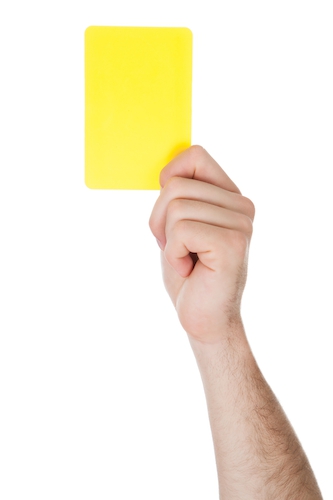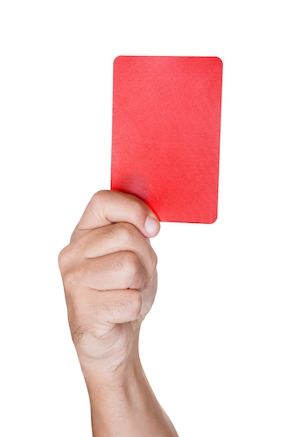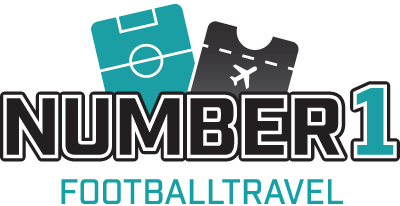Yellow and red cards
In football, players and staff membesr can be punished in two ways: by either a yellow card or a red card. A yellow card counts as a serious warning, while a red card will make you leave the pitch immediately. You can receive a red card either immediately or after two yellow cards. In this article, you can read in which situation you get which card.
The history of yellow and red cards
The first time yellow and red cards were used was during the 1970 World Cup. Before cards were introduced, the football field would often turn into a fierce battlefield. What to make of 'The Battle of Santiago' at the 1962 World Cup. Chile played the most violent match ever against Italy. The match was one big vulgar kicking party. The referee of that match was Englishman Ken Aston; the man who later came up with yellow and red cards.
While Aston stood before a traffic light, he devised the idea of yellow and red cards. It would indicate clear fouls, and everyone would know what would be coming their way. The rule got introduced eight years later. The yellow and red cards are still effective tools to avoid kicking parties.
Yellow card rules
The yellow card is used as a serious warning. Players may remain on the pitch after receiving a yellow card, but if they commit another yellow-worthy offence they must leave the pitch.
These are the fouls that lead to a yellow card:
- Unsportsmanlike behaviour: for example, kicking a ball away at a dead ball moment, asking the referee for a yellow card for the opponent or excessive cheering in front of an opponent after a goal.
- When the referee gets intimidated or called out.

- Insufficient distance when a free kick is given.
- Purposefully slowing down the resume of a game.
- Purposefully touching the ball with hands.
- Leaving the game without permission of the referee.
- Participate in the game without permission of the referee.
- Making clear that you disagree with the referee by using either words or gestures; for example, disposable gestures.
- Every form of foul play; for example, by flopping or stalling the game.
- Detaining the opponent.
- Purposefully bringing down the opponent.
- Pushing away the opponent.
- Rough play; for example, hitting the opponent hard with the shoulder and thereby showing that the player’s sole intention is to bring the man down instead of taking the ball.
- Dangerous play; for example, instead of entering a head duel, trying to catch the ball with the foot.
- Other minor acts of violance; e.g. standing with heads close together or pushing each other during a riot.
- Making the VAR gesture exaggeratingly.
- Entering the VAR room.
- Take off yourshirts.
If you retrieve a certain number of yellow cards in a season, you’ll be likely suspended. The rule in most leagues is that when you have retrieved five yellow cards, you’ll be suspended for one match. In tournaments – like World Cups – two yellow cards are enough for suspension. After the quarterfinals of the World Cup, all yellow cards expire. This is also often the case in European Championships.
Red card rules
A player ought to immediately leave the field after receiving a red card. You’ll also be suspended for a minimum of one match depending on what kind of foul was made. This gets assessed by a disciplinary committee later. You can either retrieve a red card at once or after receiving two yellow cards in one match. In this chapter, you will read everything about situations in which a red card is drawn.
- Threatening one of the players or one of the officials.
- The usage of foul language or insulting someone other than teammates.
- Protesting with hand-to-hand gestures towards officials.
- Kicking, miskicking or hitting the opponent or official.
- Spitting on the opponent or official.
- Headbutts, knee strikes and elbow strikes. Attempts are also sufficient to get a red card.
- Pushing or throwing the ball into someone’s face.
- Deliberately playing the ball with the hands: e.g., just picking up the ball or knocking it out of the goal.
- Unregulated deprive of a scoring opportunity of the opponent.
- Violent acts.
- Every form of serious foul play towards the opponent; for example, tackling someone from behind or coming in with a stretched leg.
A foul performed on a player when challenging for the ball and when it is in play outside the penalty area is subject to a free kick and a red card will be drawn. Is the foul performed within the penalthy area? Then a yellow card will be drawn, and a penalty is given to the opponents. The other remaining situations get assessed differently every time. One referee might think a hard tackle deserves to get a red card while another might think yellow is sufficient.
Extraordinary situations
Main players and substitutesare not only at risk of a yellow or red card during the match; referees may also draw cards after the match. For example, when a riot occurs in the players’ tunnel or a player scolds the referee after the whistle.
From season 2019/20, in addition to players, coaches and other managerial staff will also be at risk of receiving a card. From the season of 2022/23, all team officials sitting along the pitch can retrieve an immediate red card. That person will not be allowed to perform his or her duties for the next match.




